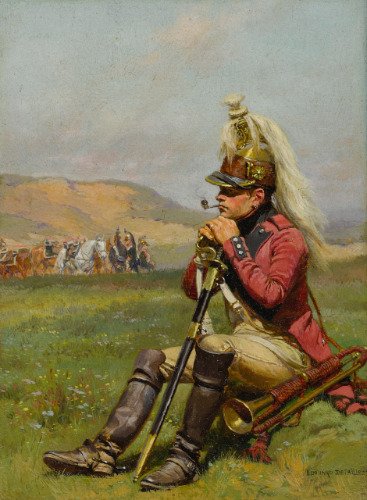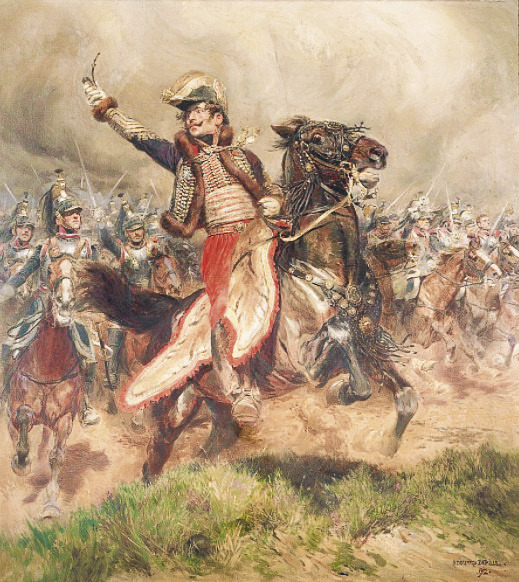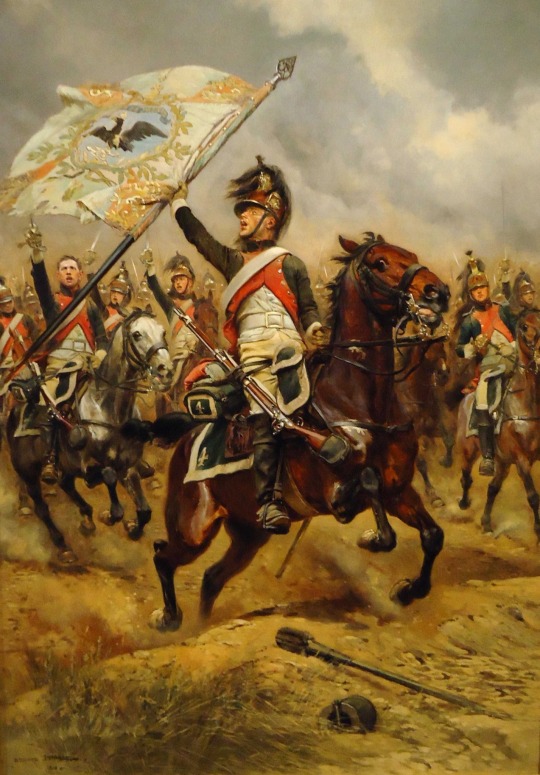#Jean-Baptiste-Édouard Detaille
Explore tagged Tumblr posts
Text

A Cavalry Officer (1887)
Jean-Baptiste Édouard Detaille (French, 1848 - 1912)
#history#military art#1800s#military#napoleonic era#napoleonic wars#napoleon#soldier#cavalry#france#late 1800s#maybe a bit later than the napoleonic era#military uniforms#French cavalry#dragoon
55 notes
·
View notes
Photo
I don’t know about the other two, but the second and third of those images are by Jean-Baptiste Édouard Detaille. He made a lot of handsome (posthumous, obviously) portraits of Napoleon and various soldiers/battles:







Some of my favourite art of young “General Bonaparte” from around Tumblr!
182 notes
·
View notes
Text

French Trumpeter Resting, by Jean-Baptiste-Édouard Detaille.
[Via Sotheby’s]
54 notes
·
View notes
Text

L'oeil du Maître by Édouard Detaille
#napoléon bonaparte#napoleon#bonaparte#cuirassiers#cuirassier#napoleonic#eye#master#art#painting#jean baptiste édouard detaille#édouard detaille#history#europe#european#france#french#napoleonic wars#cavalry#napoléon
34 notes
·
View notes
Photo

Le Rêve / The Dream (1888) by Jean Baptiste Édouard Detaille
143 notes
·
View notes
Photo

Jean-Baptiste Édouard Detaille (French; October 5, 1848 – December 23, 1912) was a French academic painter and military artist noted for his precision and realistic detail. He was regarded as the "semi-official artist of the French army".

180 notes
·
View notes
Photo

A Mounted Officer, Jean Baptiste Édouard Detaille, 1877, Art Institute of Chicago: European Painting and Sculpture
Henry Field Memorial Collection Size: 46.5 × 38.2 cm (19 1/4 × 15 in.) Medium: Oil on canvas
https://www.artic.edu/artworks/885/
174 notes
·
View notes
Photo

‘Seated Male Nude’, 1873 by Jean-Baptiste Édouard Detaille (1848-1912). French academic painter and military artist noted for his precision and realistic detail.
143 notes
·
View notes
Photo

Italian Woman Standing Holding a Jug, Italienne debout tenant une cruche by Jean-Baptiste-Camille Corot
Even though Corot himself stated that he had ‘but one aim in life and that is to paint landscapes’, he considered the figure paintings to be his most intimate works and kept the majority of them in his studio in his personal collection. His meditative models are, in Pierre Georges words, ‘the image of his dreams in the midst of his memories’ (P. Georges and A.-M. Lecoq, La peinture dans la peinture, exh. cat., Paris, 1982-1983, p. 185). Reverie becomes a leitmotif in Corot’s figure paintings, and it perhaps reveals more about the artist’s character than the landscapes. Although generous and jovial to those who knew him, the pensive expressions of Corot’s figure paintings suggest a more sensitive and melancholy soul.
During the 19th century, Corot’s figure paintings were largely overlooked as the artist chose to only exhibit four of these during his lifetime. Yet even in his landscapes the painting of the human figure was of fundamental importance in providing the action sentimentale which he considered, following the principles of de Valenciennes, to be an essential ingredient in the conception of the poetic landscape. In the 20th century, this critical neglect of his figure paintings has been for the most part reversed, and his remarkable melancholic studies of women have been particularly admired and compared to the work of Vermeer. In 1909, the exhibition of twenty-four figure paintings at the Salon d’Automne permanently altered the way Corot’s achievement in rendering the human, and particularly female, figure was appreciated.
Corot’s first series of Italian models was painted in the winter of 1825-26 during the artist's first visit to Italy. These studies demonstrate the influence of his first teacher, Achille-Etna Michallon, and show the same concern with the capturing of the textures of the fabrics, the same rapidity of execution, and the same preoccupation with the human body and lack of attention to the background. However, although the young artist shows considerable interest in documenting regional costumes, he is even more intrigued by the physical expression, the position of the body and the psychological suggestion of a personality.
In Italienne debout tenant une cruche Corot has chosen to depict his model in near full-length, facing forward and clearly gazing outside of the picture plane. Her arms are stretched out at her sides in an effort to balance the cruche perched atop her head. Her raven black hair and very dark eyes are in striking constrast to her pale skin and this is echoed in the juxtaposition of the deep claret red of her underdress and the creamy white of her apron and collar. Where Michallon would concentrate on accurately capturing the details of the costume, Corot is undoubtedly more interested in capturing the attitude of his subject, and in this case, her overt sensuality.
Indeed, it is in his figure paintings, Corot comes closest to being considered a painter of modern life. The American painter John LaFarge wrote in 1908, 'the extraordinary attainment of Corot in the painting of figures is scarcely understood today even by many of his admirers and most students. And yet the people he represents, and which he represents with the innocence of a Greek, have a quality which has skipped generations of painters' (J. LaFarge, The Higher Life in Art: A Series of Lectures on the Barbizon School of France Inaugurating the Scammon Course at the Art Institute of Chicago, New York, 1908, p. 162).
Even one of the foremost artists of the Impressionist movement, Edgar Degas, expressed his admiration for Corot’s rendering of the human form. Degas, who, when asked to agree that Corot knew how to draw a tree, replied, 'Yes, indeed...and I think he is even finer in his figures' (Moreau-Nélaton in A. Robaut, op. cit. 1905, vol. 1, p. 336). Corot’s figural works resonated with the artists of the Impressionist movement and beyond, and his young women’s haunting visages found expression in the figurative and abstract work of Picasso, who became interested in Corot in the 1910s, making a free copy of one of his figure portraits.
This work, most likely executed in his studio upon his return from his first trip to Italy when he was just starting out on his journey as an artist, remained in his studio his entire life and was not sold until after his death. Corot considered his small portraits and figure studies to be very personal objects, and he would rarely part with them. It is in these renditions, that we see a different side of an artist known primarily for his landscapes – we see a glimpse into his soul. Even this early in his long and productive career, Corot has essentially shattered the narrative in favor of a purely painterly execution. Corot painted ‘for the pleasure of painting, for the joy of capturing on canvas a lovely dark gaze or harmonizing the white blouse with the yellow of a sleeve or the red of a skirt’ (É. Moreau-Nélaton, ‘Les figures de Corot,’ L’Art et les artistes, 2 December 1905, pp. 178-179). The young artist is experimenting with the concept of rendering the human figure directly, and the painterly depiction of his model becomes an end unto itself. By not placing his model into any historical, narrative or topological context Corot makes a leap into modernity that will be seized upon by the artists of the Impressionist and Modern movements of the late 19th and early 20th centuries such as Édouard Manet. Much of the power of this intimate painting is embedded in the directness and intensity of her gaze, which is that is a very real woman and not an idealized ‘type’, which creates the unusual intimacy found within this extraordinary painting.
In 1896, 21 years after Corot’s death, André Michel wrote, ‘If one could place on one side of a gallery the ‘official’ compositions that Corot painted in his first years – following the rules and for submission to the Salon to be judged by his masters and the public – and on the other side the small studies he made on his own…one would be struck by the deep differences between them. He seems as constrained and forced in the one group as he is spontaneous, original and charming in the other’ (A. Michel, Notes sur l’art moderne (peinture): Corot, Ingres, Millet, Eug. Delacroix, Raffet, Meisonnier, Puvis de Chavannes. À travers les Salons. Paris, 1896, p. 14).
11 notes
·
View notes
Text
Pronunciation of the marshalate
Firstly, I am very sorry that I did not do double checks before reposting content again. So, after some thoughts, I decided to make a better version of our own.
//
Notes:
- All pronunciations of names are transcribed into English sounds (as much as possible)
- Since the [y] sound is absent in English, I decided to use the u-umlaut (ü) in German (and Mandarin Chinese pinyin) which was the closest to the “u” in French. The sound is the closest to “u” as in “pure” in English.
- the guttural “r” in French is going to be denoted with “hr”
- “an”, “on” and “in” are nasal sounds
- Please note that even native speakers disagree on some pronunciations
//
Charles Pierre François Augereau (O-zher-hro)
Jean-Baptiste Jules Bernadotte (Ber-nah-dot)
Louis-Alexandre Berthier (Behr-ti-yer)
Jean-Baptiste Bessières (Be-si-ehr)
Guillaume Marie-Anne Brune (Brüne)
Louis-Nicolas Davout (Dah-voo)
Jean-Baptiste Jourdan (Zhoohr-don)
François-Étienne-Christophe Kellermann (Ke-ler-mahn)
Jean Lannes (Lahn)
François Joseph Lebfevre (Le-fevhr)
André Masséna (Maa-sen-na)
Bon-Adrien Jeannot de Moncey (Mon-sey)
Adolphe Édouard Casimir Joseph Mortier (Mohr-ti-yer)
Joachim-Napoléon Murat (Mü-hra)
Michel Ney (it’s between Neh and Nay)
for details, watch this clip of our ginger babe demanding soup (source: Jean-Roch Coignet TV série)
#SoupepourNey #SoupforNey
Catherine-Dominique de Pérignon (Pe-hri-zhnon)
Jean-Mathieu-Philibert Sérurier (Se-hrü-hri-ehr)
Jean-de-Dieu Soult (Soo)
Claude Victor-Perrin (Vik-tor-Per-hran)
Étienne Jacques Joseph Alexandre MacDonald (Mack-Don-nal)
Auguste Frédéric Louis Viesse de Marmont (Mahr-mon)
Nicolas Charles Oudinot (Oo-di-no)
Louis-Gabriel Suchet (Sü-shay)
Laurent de Gouvion-Saint-Cyr (Goo-vi-on-Son-Seehr)
Józef Antoni Poniatowski (Pon-ee-ah-tov-ski)
Emmanuel de Grouchy (Ghroo-shee)
I hope I get everything right, also here I would like to thank @histoireettralala for helping me to make this post happen🙈
#this is for consolidating my own knowledge on French pronunciations as well Lol#literally tried to read every name out loud by myself when typing everything on it#still can’t pronounce my babey’s name (sob)#marshal babeys#marshal babies#napoleon’s marshals#featuring a ginger babey who needs soup#soupe pour Ney#soup for ney#michel ney#marshal bae#ginger babey#important post
88 notes
·
View notes
Photo

Jean-Baptiste Édouard Detaille (1848-1912), Reclining Male Nude, 1880
74 notes
·
View notes
Text
Edouard Manet: The Balcony

Edouard Manet, The Balcony, 1868-1869, Oil on canvas, H. 170; W. 124.5 cm, Musée d’Orsay, Paris
The Balcony
When Manet painted this piece, scenes of bourgeois life were in vogue, yet The Balcony went against the conventions of the day. The painting tells no story or anecdote; the protagonists are frozen, as if isolated in an interior dream, evidence that Manet was freeing himself from academic constraints, despite the obvious reference to Majas on the Balcony by Francisco Goya, (Google Arts and Culture and Musee d’Orsay)
Click to enlarge:
See Images At Sunnyside - Where Truth and Beauty Meet
Unique Styles
Manet’s paintings were influenced by the Impressionists, yet he was uninterested in becoming involved with exhibitions during this era in art. He was more keen on displaying his works at the Salon, so he could avoid any notions that he was a representative of the impressionist style of painting. Although Manet was also fond of using lighter colors, his paintings often had a hint of black, which was not typical in most paintings during his time. (Quote from http://www.manet.org/)
Video from Smarthistory
The Subjects
The three principal figures depicted were each friends of the artist. From left to right they are: the painters Berthe Morisot, and Jean Baptiste Antoine Guillemet, and Fanny Claus, a violinist. Some have suggested that the fourth figure, barely visible in the shadows, is the young Leon Leenhoff, the son of Manet’s wife. (smarthistory)
The subjects seem to be disconnected from each other: while Berthe Morisot, on the left, looks like a romantic and inaccessible heroine, the young violinist Fanny Claus and the painter Antoine Guillemet seem to display indifference… Just behind the railings, there are a hydrangea in a ceramic pot, and a dog with a ball below Morisot’s chair.[2]
This was the first portrait of Morisot by Manet. Manet adopts a retrained colour palette, dominated by white, green and black, with a accents of blue (Guillemet’s tie) and red (Morisot’s fan).
Manet deliberately eschewed any sense of connection between the figures, treating them more like objects in a still life than living people. None of them looks at the others.

The painters Berthe Morisot, and Jean Baptiste Antoine Guillemet, and Fanny Claus, a violinist
“Close the shutters!”
At its presentation at the 1869 Salon, this enigmatic group portrait was overwhelmingly misunderstood. “Close the shutters!” was the sarcastic reaction of the caricaturist Cham while another critic attacked “this gross art” and Manet who “lowered himself to the point of being in competition with the painters of the building trade”.
The vividness of the colours, the green of the balustrade and shutters, the blue of the man’s tie, as well as the brutal contrast between the white dresses and the darkness of the background, were perceived as provocation. The hierarchy usually attached to human figures and objects has been disregarded: the flowers receiving more detail than some of the faces.
It is not surprising then, that a painting which took such liberties with tradition, convention and realism so shocked its early public. (Google Arts and Culture and Musee d’Orsay)
See Video From Musée d’Orsay below
“Everything is mere appearance, the pleasures of a passing hour, a midsummer night’s dream. Only painting, the reflection of a reflection – but the reflection, too, of eternity – can record some of the glitter of this mirage.”
Édouard Manet
View on Wordpress blog At Sunnyside - Where Truth and Beauty Meet
Click for enlarged image detail:
(improperly displayed on WordPress Reader and Tumblr –
please visit At Sunnyside to view
Details
Title: The Balcony
Date Created: 1868 – 1869
Provenance: Gustave Caillebotte bequest, 1894
Physical Dimensions: w1240 x h1700 mm
Painter: Edouard Manet
Original Title: Le Balcon
Credit Line: © RMN (Musée d’Orsay) / Hervé Lewandowski
Artist Information:http://www.musee-orsay.fr/en/collections/dossier-manet/chronology.html
Type: Oil on canvas
Rights: Musee d’Orsay, dist. RMN / Patrice Schmidt
External Link: http://www.musee-orsay.fr/en/collections/works-in-focus/search/commentaire_id/the-balcony-7199.html?tx_commentaire_pi1%5BpidLi%5D=509&tx_commentaire_pi1%5Bfrom%5D=841&cHash=ed0bf50b6e
Provenance
The Balcony was exhibited at the Paris Salon of 1869, and then kept by Manet until his death in 1883. It was sold to the painter Gustave Caillebotte in 1884, who left it to the French state in 1894. It is currently held at the Musée d’Orsay, in Paris.
Sources
“The Balcony” by Edouard Manet, Google Arts and Culture, accessed June 24, 2018, https://artsandculture.google.com/asset/the-balcony/ggFK0UgXAd7OCA?hl=en
Edouard Manet, “The Balcony”, Musée d’Orsay, Paris, accessed June 24, 2018, http://www.musee-orsay.fr/index.php?id=851&L=1tx_commentaire_pi1[showUid]=7121&no_cache=1
Edouard Manet, “Édouard Manet and His Paintings”, accessed June 23, 2018, http://www.manet.org/
Wikipedia contributors, “The Balcony (painting),” Wikipedia, The Free Encyclopedia, https://en.wikipedia.org/w/index.php?title=The_Balcony_(painting)&oldid=843091653 (accessed June 25, 2018).
Wikipedia contributors, “Édouard Manet,” Wikipedia, The Free Encyclopedia, https://en.wikipedia.org/w/index.php?title=%C3%89douard_Manet&oldid=846867856 (accessed June 25, 2018).
youtube
youtube
5 notes
·
View notes
Text
21 Works, October 5th. is Édouard Detaille's day, his story, illustrated with footnotes #217
21 Works, October 5th. is Édouard Detaille’s day, his story, illustrated with footnotes #217
Jean-Baptiste-Edouard DetailleThe last charge of General Lasalle, killed at Wagram on July 6, 1809, c. 1912Musée de l’Armée Antoine-Charles-Louis, Comte de Lasalle (10 May 1775, Metz — 6 July 1809, Wagram) was a French cavalry general during the Revolutionary and Napoleonic Wars, often called “The Hussar General”. He first gained fame for his role in the Capitulation of Stettin. Over the course…

View On WordPress
#Art#Artists#Édouard Detaille#Biography#d&039;Hautpoul#Fine Art#fineart#footnotes#General Lasalle#History#Hussars#King Edward#Louis Lepic#Napoleon#Paintings#Zaidan
0 notes
Text

'Le Trophée' French dragoon with captured Prussian flag at the Battle of Jena-Auerstedt, 1806 by Jean Baptiste Edouard Detaille
#édouard detaille#art#painting#history#france#empire#napoleonic#napoleonic wars#dragoon#french dragoon#prussia#prussian#flag#jean baptiste édouard detaille
45 notes
·
View notes
Photo

Oficiales franceses interrogando a prisioneros austriacos durante las Guerras Napoleónicas, cortesía de Jean Baptiste Édouard Detaille. https://ift.tt/2qKYYeB https://ift.tt/2HbYKZ3
0 notes
Photo

A Mounted Officer, Jean Baptiste Édouard Detaille, 1877, Art Institute of Chicago: European Painting and Sculpture
Henry Field Memorial Collection Size: 46.5 × 38.2 cm (19 1/4 × 15 in.) Medium: Oil on canvas
https://www.artic.edu/artworks/885/
9 notes
·
View notes